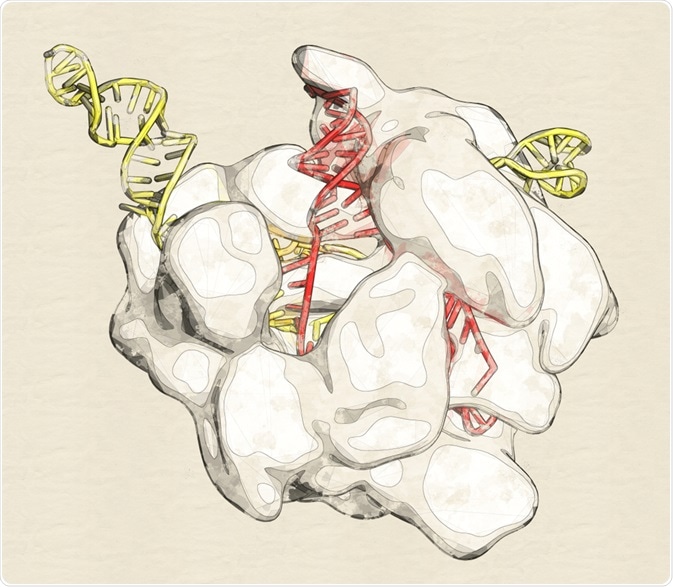
Gene Editing for Muscular Dystrophy
Skip to:
- Research in gene editing in the muscle cells
- Types of Muscular Dystrophy that have been researched
- What is genome editing, and why is it useful to patients with Muscular Dystrophy?
- CRISPR as a correction technique
- Concerns in research
Muscular Dystrophies are a group of genetic conditions characterized by muscle weaknesses. They are genetic conditions and have different sub-categories depending on which area of muscle mass is affected. Muscular Dystrophy is caused as a result of the dystrophin gene mutating; as the abnormal genes exist, there is an interference with proteins in the muscle, meaning they do not form in the same way as a healthy muscle mass would.
In the first instance, a single group of muscles is typically found to deteriorate then the condition spreads more widely throughout the muscles in the body. As a result, there is a loss of mobility and premature muscle failure.

Image Credit: Shutterstock
Research in gene editing in the muscle cells
As the disease is a genetic condition, research can be completed on the genetic system. Mutations in the muscle cells are what cause this abnormal fatality of the muscle. Research is consistently looking into cutting the mutations to restore the cells and prevent a premature fatality. Research is still relatively new and improving.
Types of Muscular Dystrophy that have been researched
There are several forms of Muscular Dystrophy; Duchenne Muscular Dystrophy, Becker, Myotonic, Facioscapulohumeral, Congenital, and Limb-girdle. Symptoms vary with the type of Muscular Dystrophy. Some Muscular Dystrophies are more common in children and some increase with age. However, all are genetic and inherited conditions.
Duchenne Muscular Dystrophy is the most common and most researched condition with respect to possible gene editing. Duchenne Muscular Dystrophy typically has its onset in males around four years old. Duchenne Muscular Dystrophy stops the potential for the production of the protein dystrophin. Muscle deterioration occurs, and the muscle cells eventually die. In children, in particular, they lose the ability to walk, and essential muscles stop functioning from a young age.
What is genome editing, and why is it useful to patients with Muscular Dystrophy?
Genome editing is a new technique in molecular biology. The genes are modified in a way in which traits and physical conditions can be corrected. Scientists use technologies that can cut DNA to edit or change DNA. In the case of Muscular Dystrophy, DNA is cut to stop early mutation of cells.
Research on Duchenne Muscular Dystrophy has used a large mammal model to test genome editing. At present, analysis is being carried out to ultimately find a cure for the condition, as currently there is no cure, leading to loss of muscle function to premature death. In the first instance, gene editing has been used to correct small faults in adult cells. However, the technique is very new in the introduction into research; therefore, it has not been tried and tested on human subjects; instead, mammals with similar genetic structures are researched.
CRISPR as a correction technique
Correction to a mutation in muscle stem cells has used the gene-editing technique called Clustered Regularly Interspaced Short Palindromic Repeats (CRISPR). CRISPR creates the possibility for correction of the genetic mutation in the cells, the mutation of the cells that are responsible for the disorder. Correcting the mutation in stem cells means that the regenerated cells from the edited stem cells will no longer carry the mutation.
 molekuul_be | Shutterstock
molekuul_be | ShutterstockMDX mice are regularly studied in modeling Duchenne Muscular Dystrophy disease, using the CRISPR technique in gene editing, as they have similar muscle developments as humans. The mice exhibit compulsive deterioration and regeneration of myofibers, which is similar to that of Muscular Dystrophy. MDX mice have the disease phenotype but it is milder compared to humans. CRISPR technique is used before the mice can be tested in the clinic in order to be as close to human cell developments in patients with Muscular Dystrophy.
Similarly, a golden retriever dog has been studied in relation to Duchenne Muscular Dystrophy as they have the nearest pathological counterpart of the disease. Advances in gene editing and replacement may help bring about successful treatments for human genetic disorders.
Concerns in research
Thus far, research on gene editing in Muscular Dystrophy has been limited. There is also a concern that, because muscle cells can wear out over time, relapses may be possible even after successful gene editing.
Thus far, the MDX mouse model findings have not been translated into human studies. Mouse symptoms are not the same as that of humans as they do not have the same gene mutations as they are genetically modified for scientific purposes. In addition, there is a lack of severe phenotypes in the MDX genotype; therefore, it is difficult to understand the side effects and symptoms of gene-editing when it comes to a human subject.
The use of the mouse model in some instances is not useful, as the mouse model differs in many ways compared with the human disease.
Research can still be deemed useful as the model can be utilized to ensure results can be taken. Focusing on the smaller aspects of the study and analysing the movements of the mice instead of the overall genetic results it can change the perspective of genome editing in small mammals to then be used in human studies.
References:
- https://www.genome.gov/about-genomics/policy-issues/what-is-Genome-Editing
- Nance, M., et al (2019). AAV9 Edits Muscle Stem Cells in Normal and Dystrophic Adult Mice. Molecular Therapy, 2019. https://www.ncbi.nlm.nih.gov/pubmed/31327755
- https://www.musculardystrophyuk.org/your-stories/understanding-genome-editing/
- Yucel, N., et al., 2018. Humanizing the mdx mouse model of DMD: the long and the short of it. NPJ Regenerative medicine. https://www.nature.com/articles/s41536-018-0045-4
Further Reading
Last Updated: Feb 13, 2020
.jpeg)






















.png)









No hay comentarios:
Publicar un comentario